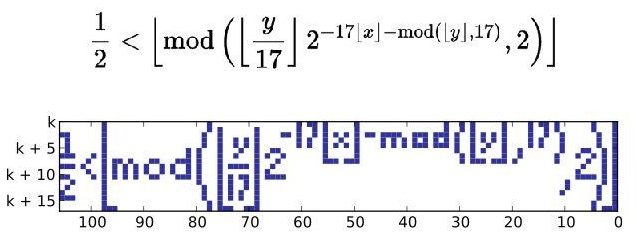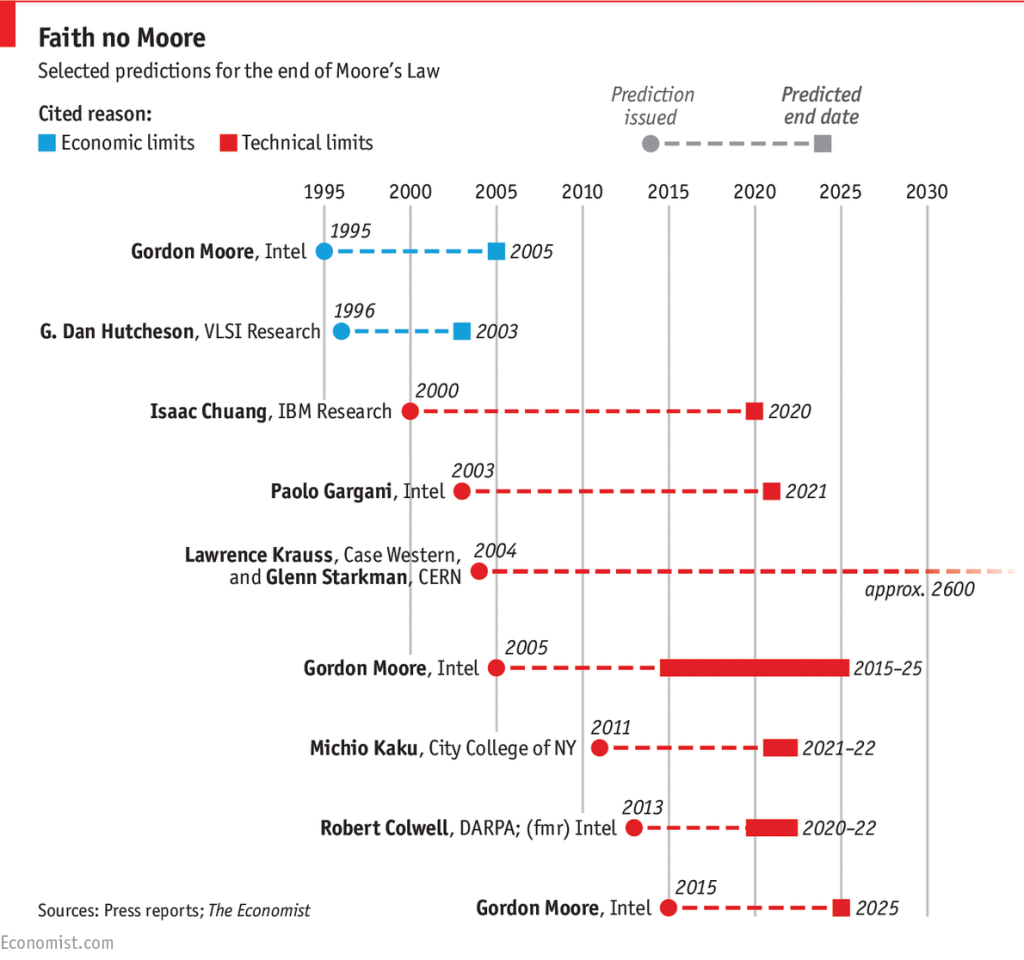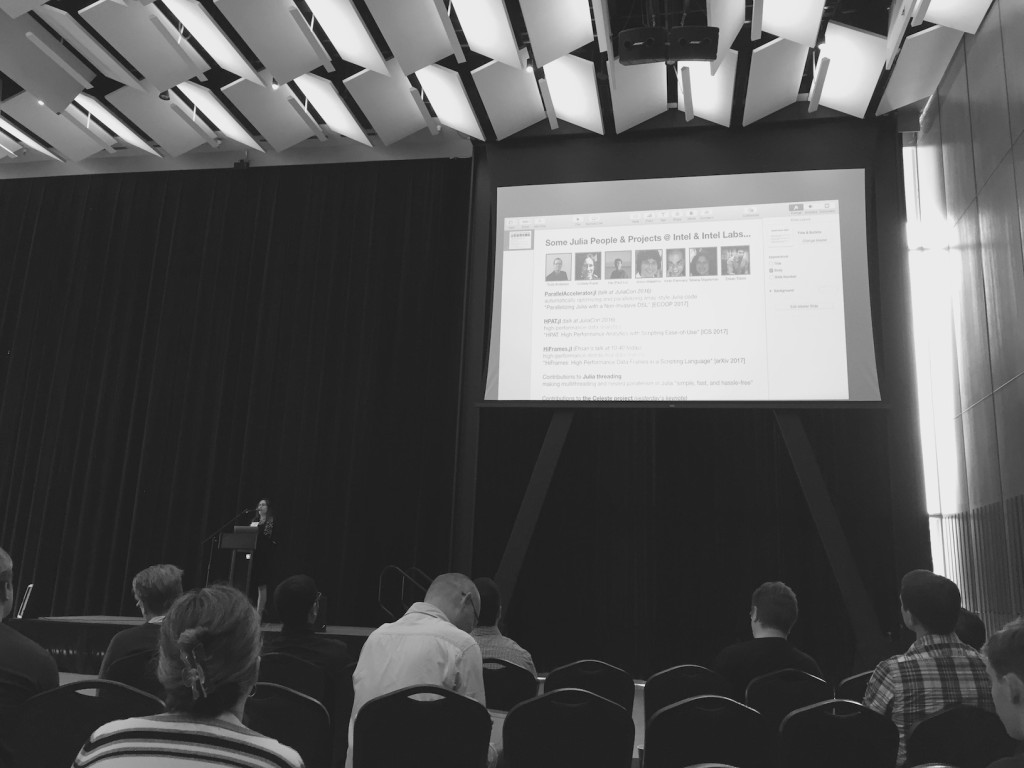Subluminal
Slower than the speed of light, but not by much
Category Archives: language
Self-reference
Self-reference is cornerstone in Hofstadter’s Godel-Escher-Bach, a must read book for anyone interested in logic (and we shall rely logic in these days to stay sane.)
Here’s a bunch of examples of self-reference that I found interesting, curated just for you!Barber’s paradox:The barber is the “one who shaves all those, and those only, who do not shave themselves.” The question is, does the barber shave himself?
Self-referential figure (via xkcd):
 Tupper’s formula that prints itself on a screen (via Brett Richardson)
Tupper’s formula that prints itself on a screen (via Brett Richardson) Continue reading
Continue reading
Moore’s wall
A single chip such has Intel Xeon Phi has a computational power in excess of 1TFLOPS and features more than a hundred billion transistors. Few people outside the world of semi-conductor engineering appreciate this, but that is a fantastical number: 100,000,000,000. If every transistor was a pixel, you would need a wall 0f 100 x 100 4K TV screen to display them all!
Over the past fifty years, the semiconductor industry has achieved incredible things, in part thanks to planar technology, which allowed to exponentially scale the manufacturing process, following Moore’s law. But it seems that we’re about to hit a wall soon. Let’s give an overview of where we stand, and where do we go from here! Continue reading
Let’s give an overview of where we stand, and where do we go from here! Continue reading
Quick’n’dirty
Over the years I’ve collected quotes from people who are.
I always like quotes, because they are atoms of knowledge, quick and dirty ways to understand the world we only have one life to explore. To some extent, they axioms of life in that they are true and never require an explanation (otherwise they wouldn’t be quotations.)Here’s a bunch of quotes that I found particularly interesting, starting with my absolute favorite quote comes from the great Paul Valery:The folly of mistaking a paradox for a discovery, a metaphor for a proof, a torrent of verbiage for a spring of capital truths, and oneself for an oracle, is inborn in us. – Paul Valery
On research — trial and error
Basic research is like shooting an arrow into the air and, where it lands, painting a target.
-Homer Burton Adkins
– Friedrich Nietzsche
Continue reading
Learning Deep
In the past four years, there’s been a lot of progress in the field of machine learning, and here’s a story seen from the outskirts.
Eight years ago, for a mock start-up project, we tried to do some basic headtracking. At that time, my professor Stéphane Mallat told us that the most efficient way to do this was the Viola-Jones algorithm, which was still based on hard-coded features (integral images and Haar features) and a hard classifier (adaboost.)(I was thrilled when a few years later Amazon Firephone was embedding similar features; unfortunately, this was a complete bomb — better technologies now exist and will make a splash pretty soon.)
By then, the most advanced book on machine learning was “Information Theory, Inference, and Learning” by David McKay, a terrific book to read, and also “Pattern Recognition and Machine Learning” by Chris Bishop (which I never read past chapter 3, lack of time.)
Oh boy, how things have changed! Continue readingBooks I loved
With every year comes the occasion to read new books!
I’ve assembled a small collection of books that I love, so that you can discover them and share the love around! Since there are twelve months in a year, you’ll find twelve books. They are presented in no particular order, so that you can enjoy them at random, sitting in a couch sipping some wine.Ringolevio (Emmett Grogan)
Ringolevio is a sort of autobiography by Emmett Grogan, a leader of the Diggers in San Francisco just about when it was becoming cool (early 60s). It is a great book in that it is written with a punch, and has a deep sense of social awareness. It is quite fun to read Timothy Leary and other fake-prophets of the revolution getting thrashed.
Emmett wondered whether anything viable was going to come out of it: whether the powerless might for once obtain enough power to make some sort of relevant change in the society. He immediately dismissed as ridiculous the notion that everything would be all right when everyone turned on acid. It was noted that LSD was used during World War Two to solve naval tactical maneuvers, and they concluded that although the drug might facilitate understanding or the process of doing something, it offered no moral direction or imperatives.
There is no road (Antonio Machado)
This is my absolute favorite poem books. It is very short, and has the deepest thoughts ever assembled in a book. This book is a treasure, and I have offered it to people I care about. This book is often out of print, but don’t settle for a different collection, this one is really unique if you can find it, and by far the best translations I’ve found.
Between living and dreaming there is a third thing. Guess what it is
– Antonio Machado
Julia Language
A few years ago, I got interested in the then-nascent Julia language (julialang.org), a new open source language based on Matlab syntax with C-like performances, thanks to its just-in-time compiler.

Large Synoptic Survey Telescope (LSST, Chile) data being processed with Julia on super computers with 200x speedup (from https://arxiv.org/pdf/1611.03404.pdf)
It now seems that the language is gaining traction, with many available packages, lots of REPL integration (it works with Atom+Hydrogen, and I suspect Jupyter gets its first initial from Julia and Python) and delivering on performances.
Julia is now used on supercomputers, such as Berkeley Lab’s NERSC, taught at MIT (by no less than Steven G Johnson, the guy who brought us FFTW and MEEP!), and I’ve noticed that some of the researchers from Harvard’s RoLi Lab I’ve invited to SPIE DCS 2018 are sharing their Julia code from their paper “Pan-neuronal calcium imaging with cellular resolution in freely swimming zebrafish“. Pretty cool!I got a chance to attend parts of Julia Con 2017 in Berkeley. I was amazed by how dynamic was the the community, in part supported by Moore’s foundation (Carly Strasser, now head of Coko Foundation), and happy to see Chris Holdgraf (my former editor at the Science Review) thriving at the Berkeley Institute for Data Science (BIDS).
I started sharing some code for basic image processing (JLo) on Github. Tell me what you think!
(by the way, I finally shared my meep scripts on github, and it’s here!)Soft power
During the past twelve months, I become enamored with Middle-Eastern music who now wears many clothes, from electro to Queen-esque Arabic music.
Since it’s Thanksgiving, here are some offerings!
Never underestimate the healing power of music
– Mark Kozelek/Sun Kil Moon
Acid Arab is a French DJ band who mixes Arab tunes with electronic music. Their mix at the Sonar 2016 is an absolute masterpiece, blending fantastic rythms with melodies rarely heard in electronic music.
Mash’rou Leila is a Lebanese band, extremely popular in the Middle-East. It is very varied, and the singer Hamed Sinno has a Freddie Mercury-like persona, and brings lot of poetry. Shim El Yasmine is a song that talks about the odor of the jasmine of his partner at the time, who went on leave him to marry a woman, because society wouldn’t understand that love is love… A week before I went to see them live at Slim’s in San Francisco, the band had been banned from el-Sisi’s Egypt, where people in the audience raised rainbow flags… Continue readingSexism in academia
This year, the recipients of the Nobel Prize were 100% men. That’s at the same sad and scary; sad because, and scary because it seems that things are not changing at the pace they should.
Irma
My family, living in Saint Martin (French West Indies) was hit by the Hurricane Irma on September 5th, 2017.
Today, after ten days without communications (but news here and there), I was finally able to talk with them, and it’s quite a relief to learn that they are safe now.




